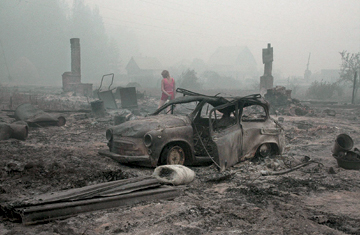
Into dust Residents of Kriusha village, in the western Russian region of Ryazan, search through the remains of their charred homes
Five weeks after wildfires began spreading through forests in central and western parts of the country, Russia is still burning. The worst is over, but as firefighters continue to push back the blaze and millions of victims set about trying to rebuild their lives, the nation must come to terms with another tragedy: the negligence of its leaders, many of whom were too slow to act — or stayed away on vacation — while fires consumed entire villages.
More than 50 people have been killed in the fires, and the death rate in Moscow has doubled amid the heat and toxic smoke. Russians whose homes and harvests have been reduced to ash are directing their outrage at the top. "We were burning. We begged you for help, and you did nothing," one woman shrieked at Prime Minister Vladimir Putin as he toured a burned-out village near Nizhny Novgorod in July.
The sense of betrayal was heightened when the fires threatened to revive one of the worst disasters in Russia's history. On Aug. 5, after the blaze had been going for almost a month, Emergencies Minister Sergei Shoigu said fire-prevention teams were focusing on forests around Bryansk, one of the regions most contaminated by the Chernobyl accident in what is now Ukraine. When the nuclear reactor exploded in 1986, it emitted hundreds of times more radiation than the Hiroshima bomb and coated most of Europe and the western Soviet Union in a radioactive haze. Millions of people were exposed, thyroid-cancer rates in children soared, and thousands are thought to have died from the fallout. "If fires break out [in Bryansk], radioactive particles could be stirred up along with the fumes from the fire, and a new zone of contamination could emerge," Shoigu told reporters. "I hope we will be able to get through this without fires turning up there."
No such luck. On Aug. 10, the Russian arm of Greenpeace said 20 fires were raging in forests affected by Chernobyl, with three of those in the fallout zones of Bryansk. As evidence, Greenpeace superimposed a satellite map of the burning sites onto a map from the International Atomic Energy Agency showing where radiation had seeped into the soil and vegetation after Chernobyl. The two clearly overlapped. Three days later, a deputy for the regional parliament in Bryansk, Lyudmila Komogortseva, found that radiation levels in the burning forests were six to 12 times higher than they were before the fires began.
But just as Moscow kept many of Chernobyl's victims in the dark for days about the dangers they faced — volunteer cleanup crews worked in the wreckage with their bare hands, unaware that they were being exposed to lethal doses of radiation — Russia's leaders again tried to pretend nothing was wrong. Official denials came thick and fast, first from the government's chief physician, Gennady Onishchenko, who in response to Greenpeace's revelation told the Interfax news agency, "There's no need to sow panic. Everything [in Bryansk] is fine." But in a rare break in the federal ranks, the state forestry-protection agency, RCFH, published details on its website showing that as of Aug. 6, contrary to Onishchenko's assurances, there were 28 wildfires in Bryansk covering 269 hectares, including 9 hectares in the most radioactive parts of the region's southwest.
That was when Shoigu changed his line about the risk of radiation and rebuked the RCFH for spreading "false information." Hours later, the agency's website went down, and it remained inaccessible until the morning of Aug. 18 — when it went back online with no mention of the Bryansk fires. RCFH deputy director Nikolai Bobrinsky told TIME that the agency was just following a request from the Emergencies Ministry that it stop going public with information about the fires to avoid spreading panic.
This means that for now, all information from the fallout zones comes through the ministry. On Aug. 18, it organized a trip to Bryansk for observers and environmentalists. Ivan Blokov, who went on behalf of Greenpeace, says the trip left some of the most crucial questions unanswered and convinced him only that the region's firefighting infrastructure is "in a state of collapse" and would be unable to contain a major fire in the radioactive forests.
According to Komogortseva, who took a helicopter tour of the region with ministry officials on Aug. 18, the fires in Bryansk finally seem to have been extinguished. Yet thousands of tons of radioactive deadwood still litter the forest floor, she says. The wood could release a cloud of radiation if ignited. The levels would be a tiny fraction of what Chernobyl poured into the atmosphere 24 years ago, but experts have warned that winds could carry radioactive particles deep into Europe, and the effects are difficult to predict because of the lack of reliable data from Bryansk.
Some European officials are worried. Vice President of the European Parliament Rodi Kratsa said in a letter to the chamber last week that there are "serious risks" of radiation reaching Europe and asked her fellow deputies to find out whether Russia has a "prevention plan ... to avoid the release of radioactive particles into the atmosphere." Right now, though, the only such plan in Moscow seems to be aimed at preventing information leaks that could embarrass the government. To the Russians who have lost their homes, their livelihoods and their loved ones, that's not nearly enough.
